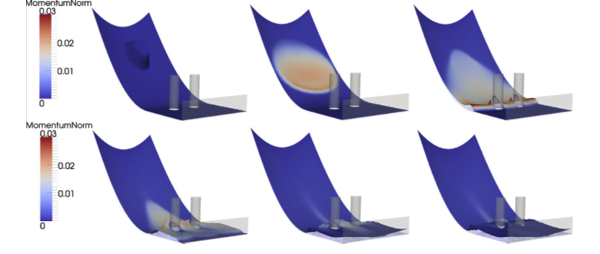Presentation of the concept of technology/product
Presentation of preliminary results
A depth integrated theory, obeying a Mohr-Coulomb type yield criterion, was introduced by Savage and Hutter [SH89], [SH91] and developed thereafter by many authors (see for instance [ID01], [M03], [M05], [PH]). These models cannot be used for fluids which exhibit cohesional properties, hence they exclude the classical Bingham model (Von-Mises plasticity). Another depth integrated theory was obtained in [I10] for fluids with a Drucker-Prager type yield criterion (which includes the Bingham model) flowing down inclined planes. The resulting shallow model of this last theory, which have the same structure as the three dimensional one, has a "shallow flow/no flow" (yield) condition and a "shallow viscosity". This shallow yield criterion was used in [I10], [IL15], [IL16] to define a "safety factor" (or a limit load) which characterizes whenever the fluid/solid flows from a rest configuration (avalanche onset).
Natural avalanches and debris flows are often associated to complicated mountain topologies, which makes the prediction very difficult. That is why a lot of studies attempt to include the bottom curvature effect into the classical Saint-Venant or Savage-Hutter [SH89] equations. The first generalizations concerns channelized flows along talwegs [GWH99], [WGH99], [PH03], [WHP04] (see also the review a [A], [PHE03]) and flows on more general basal geometries [K], [BMPV], [BFML]. The extension the visco-plastic Saint-Venant model, obtained in [I10] for plane slopes, to the case of a general basal topography (i.e. for any parametrization of the bottom surface) was done very recently in [I12]. Even if the principal steps in deriving the shallow equations are the same as in case of a plane slope, the main difficulty was to handle a local base given by the bottom geometry and the associated differential operators. The expressions of the shallow momentum balance law and of the evolution equations for the thickness have the same structure as in [I10], but we have to interpret them in terms of tangential differential operators associated to the bottom geometry. The "shallow constitutive equation" links the projection of the averaged stresses on the tangent plane to the rate of deformations expressed through the tangent differential operators.
In [I13] it have been developed a robust numerical algorithm for the visco-plastic Saint-Venant model proposed in [I12] (see Figure 3 for an illustration). An implicit (backward) Euler scheme for time discretization, which gives a coupled system of nonlinear equations for the velocities and thickness fields, was used. At each time iteration, an iterative algorithm is developed to solve these nonlinear equations. Specifically, a mixed finite-element and discontinuous Galerkin strategy is proposed. The equations for the velocity field are discretized using the finite element method, while a discontinuous Galerkin method, with an upwind choice of the flux, is adopted to solve the hyperbolic equations that describe the evolution of the thickness.

Figure 3. Evolution of the domain occupied by a "Drucker-Prager fluid" (no cohesion) during an avalanche with obstacles: the evolution of the thickness with momentum norm in the color scale (from [I13]).
To handle the non-differentiability of the plastic terms an iterative decomposition-coordination formulation coupled with the augmented Lagrangian method (see [GlLT], [FG], or more recently [DGG]) is adapted. Since for the "shallow constitutive equation” there is no co-axiality between the stress and the rate of deformation tensors, the original method, developed for the Bingham model [GlLT], [FG], cannot be used directly. This problem is specific to the general case (two dimensions) and it is not present in the one-dimensional case, where the stress and rate of deformation are scalars (see the well balanced method proposed in [BFIV]). To overcome this difficulty the shallow visco-plastic model as a constitutive law has been written in three dimensions and then the decomposition-coordination formulation has been used. It is worth noting that this type of algorithm permits also to solve alternatively, at each iteration, the thickness equations.
We have to mention here another approach of the same phenomena obtained by the researchers of our team. A probabilistic model and a numerical approach were proposed in [BeDeLu] for the fragmentation phase of an avalanche, based on an appropriate stochastic differential equation of fragmentation.
